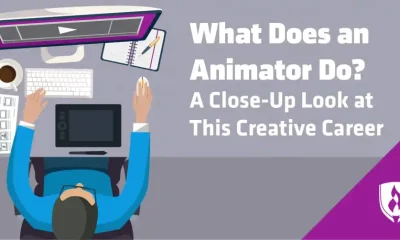Business
Exploring the Prospects and Hurdles within Motion Graphics Animation
Published
7 months agoon
By
John
Introduction:
Motion graphics animation has become an integral part of visual communication, blending creativity and technology to convey messages in a dynamic and engaging manner. In this article, we will delve into the vast world of motion graphics animation, exploring its prospects and the hurdles that creators face in this dynamic field.
The Rise of Motion Graphics Animation:
Motion graphics animation has witnessed a meteoric rise in recent years, thanks to its versatility and ability to capture attention. From advertisements to social media content, the demand for visually appealing animations has surged, making motion graphics a powerful tool for communication.
Versatility in Communication:
One of the key prospects of motion graphics animation lies in its versatility. Unlike static visuals, animations can convey complex messages in a simplified and engaging manner. Businesses, educators, and content creators are leveraging this versatility to reach their target audiences more effectively.
Creative Expression and Storytelling:
Motion graphics animation provides a unique canvas for creative expression. Artists and animators can bring ideas to life, using movement and design to tell compelling stories. This aspect has led to a growing community of storytellers who use animation as a medium to convey narratives with emotional impact.
Engaging Social Media Content:
Social media platforms thrive on eye-catching content, and motion graphics animation fits the bill perfectly. From short explainer videos to animated GIFs, creators can generate content that not only grabs attention but also encourages social sharing, enhancing visibility and engagement.
Challenges in Technical Advancements:
Despite the promising prospects, best motion graphics video agency faces challenges in keeping up with rapid technological advancements. Staying current with software updates and mastering new tools can be a hurdle for animators, requiring continuous learning and adaptation.
Balancing Aesthetics and Message Clarity:
Achieving the right balance between aesthetic appeal and message clarity is a common hurdle in motion graphics animation. Overly complex animations may distract viewers from the intended message, emphasizing the need for thoughtful design that enhances rather than hinders business communication.
Resource Intensity and Time Constraints:
Creating high-quality motion graphics animation often demands significant resources, both in terms of skilled personnel and time. Tight deadlines and client expectations can add pressure, making it crucial for animators to manage resources efficiently without compromising on the quality of the final product.
Client Education and Expectation Management:
Educating clients about the capabilities and limitations of motion graphics animation is essential. Managing client expectations regarding timelines, revisions, and the creative process can be challenging, requiring effective communication and a mutual understanding of the medium.
Evolution of Industry Standards:
The motion graphics animation industry is in a state of constant evolution. Keeping pace with changing industry standards and trends is essential for animators to remain competitive. Embracing new technologies and techniques becomes a hurdle for those who resist change or struggle to adapt quickly.
The Future of Motion Graphics Animation:
Looking ahead, the future of motion graphics animation appears promising. As technology continues to advance, new possibilities and tools will emerge, offering animators even more creative avenues. Overcoming current hurdles will be crucial for professionals in the field to capitalize on the evolving landscape and continue producing impactful animations.
Accessibility and Inclusivity in Animation:
Addressing accessibility and inclusivity within motion graphics animation is gaining traction. Designing animations that consider diverse audiences, including those with disabilities, involves incorporating features like closed captions, audio descriptions, and visual elements that cater to various needs. Ensuring that animations are accessible to a wider audience is becoming an important consideration in the field.
Cross-platform Compatibility and Optimization:
With content consumption spread across multiple platforms and devices, optimizing motion graphics for various screen sizes and resolutions poses a challenge. Animators need to create versatile animations that maintain quality and visual impact across different platforms, ensuring a consistent user experience regardless of where the content is viewed.
Sustainability and Ethical Considerations:
As the animation industry grows, there’s an increasing focus on sustainability and ethical practices. Creating animations that minimize environmental impact, whether through energy-efficient processes or reducing waste, is gaining attention. Additionally, there’s a growing awareness of ethical considerations in content creation, encouraging responsible storytelling and avoiding harmful stereotypes.
Conclusion:
Motion graphics animation stands at the intersection of creativity and technology, offering a plethora of prospects for those who can navigate its challenges. By understanding the evolving industry, mastering the tools, and balancing creativity with effective communication, animators can continue to shape the future of visual storytelling through motion graphics.

Navigating the Indian Visa Process for UK and Canadian Citizens

Navigating the Indian Business Visa Application: Common Mistakes to Avoid

Navigating the Indian Visa Process: A Guide for Vietnamese and Zambian Citizens

Navigating the Indian Visa Process: A Guide for Vietnamese and Zambian Citizens

Navigating Visa Requirements: India for French Citizens and Canada for German Citizens

Guide to Obtaining a New Zealand Visa from Switzerland

Complete Guide to New Zealand Visa for Spanish Citizens

SAUDI ARABIA BUSINESS VISA RENEWAL

Indian Visa for Cruise Passengers

NEW ZEALAND VISA FOR CANADIAN CITIZENS

Navigating the Indian Visa Process for UK and Canadian Citizens

Navigating the Indian Business Visa Application: Common Mistakes to Avoid

Navigating the Indian Visa Process: A Guide for Vietnamese and Zambian Citizens

Navigating the Indian Visa Process: A Guide for Vietnamese and Zambian Citizens



